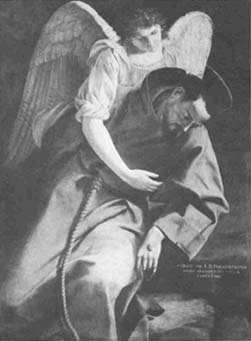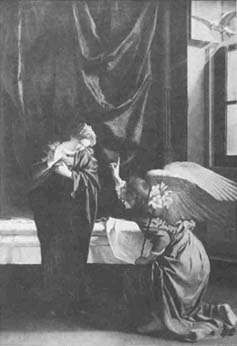
Bulletin 14, 1969
Home
Français
Introduction
History
Annual Index
Author &
Subject
Credits
Contact





Orazio
Gentileschi and the
Theme of "Lot and His Daughters"
by R. Ward Bissell
Résumé en français
Pages 1 | 2
| 3 | 4 |
5 | 6
| 7 | 8
In February of 1621, Alessandro Ludovisi of Bologna ascended to
the papacy as Gregory xv. The aspirations of Giovan Antonio Sauli,
a Genoese nobleman who had come to Rome for the papal balloting,
were thereby frustrated, since Antonio Maria Sauli, Archbishop of
Genoa, had been a prime candidate. (1) For the professional career of
the Roman baroque painter, Orazio Gentileschi (1563-1639), these
events proved to be momentous. It could have been predicted that the
election of Gregory xv would consolidate the position of the
Bolognese masters, already enjoying important commissions in Rome at
the expense of artists such as Gentileschi who worked within the
tradition established by Caravaggio. But whether by design or not
Orazio's immediate future suddenly acquired focus when Giovan
Antonio Sauli, obviously impressed by the paintings of Gentileschi,
invited him to Genoa. (2)
In a sense, Orazio's decision to leave Rome, to which he never
returned, had been gradually forced upon him. A study of his career
during the second decade of the century demonstrates that the
occurrences of 1621 merely gave greater urgency to a departure which
for several years had seemed imminent. (3) Gentileschi (his maternal
surname) had come to Rome between 1576 and 1578 from his
birthplace at Pisa, equipped with a rudimentary artistic education
gleaned from his goldsmith father, Giovanni Battista Lomi, from
the very early paintings of his brother Aurelio, and perhaps also
from an occasional study trip to Florence. The canvases (formerly
in San Paolo fuori le mura, and in Santa Maria at Farfa) and
frescoes (in San Giovanni in Laterano and in Santa Maria Maggiore)
which he executed during the 1590s, uninspired productions in the
tradition of Roman late mannerism, only hint at an individual
temperament. shortly after 1600, however, inspired by the art of
Caravaggio, Gentileschi began to assert a recognizable artistic
personality, as attested by the St Francis Supported by an Angel
in
the Palazzo Corsini, Rome (fig. I). Orazio's adaptation of
Caravaggio's manner was considered; he seemed to perceive the
indissoluble relationship between Caravaggio's style-direct painting
from the model with attention to realistic detail, bold lighting
comprehensive in function, restricted space - and his moral concem
for the truth of human experience. By disposition and training
Gentileschi also entertained a liking for exquisite decorative
effects and a disinclination for forms in action. The Circumcision in the Chiesa del Gesù, Ancona,
is a demonstration-piece for the former, while the
David Slaring Goliath
in the National Gallery of
Ireland, Dublin, and the superb St Michael Overcoming the Devil in
San Salvatore, Farnese (fig. 2), for all their monumentality and
dramatic lighting, are not totally convincing as violent
encounters. By 1610, having explored these alternatives, Orazio
chose to work toward increased refinement of sentiment and,
consequently, of pictorial handling. To this phase, during which he
emerged as the most original painter among the Roman caravaggeschi, belong such works as the
Judith with Ber Maidservant
in the
Wadsworth Atheneum at Hartford, Connecticut (fig. 3) and the ceiling
frescoes for the Casino of the Muses
in the garden of the present
Palazzo Pallavicini-Rospigliosi. Yet the scandal of 1612, involving
his daughter Artemisia and Agostino Tassi, and, I suspect, the
growing interest of patrons in the art of the Bolognese painters
seem to have compelled Orazio to seek commissions outside of Rome.
Beginning about 1613, he produced several important paintings for
churches in Fabriano (Duomo, Santa Lucia, Santa Caterina, San
Benedetto). Attempts to obtain work in Venice (in 1617) and at
Pesaro (in 1619), during pauses in his activity for Fabriano, were,
however, unsuccessful. (4)
Thus when Gentileschi was assured of employment by Sauli when the
two men met in 1621, he was fully prepared, if not anxious, to leave
Rome. For his new patron Orazio executed several paintings,
including one of Lot and His Daughters, probably identifiable as the
example which was still in Genoa at the beginning of this century
(fig. 5; Appendices I, I and II, 1). (5) This picture, the
first of four versions by Orazio Gentileschi of this theme, is
known only in the photograph which is published here for the first
time. It is very closely related to the canvas that has occasioned
the present article, the
Lot and His Daughters
in the National
Gallery of Canada (fig. 6; Appendix 1, 2).
Unfortunately, the early history of the painting now in Ottawa
remains uncertain. It is first cited, without indication as to its
provenance, in an inventory dated 1752 of the Orléans collection in
France. Such an impasse is hardly acceptable to the art historian;
thus two theories, neither of which is conclusive, have been
offered. The principal arguments, which are discussed in detail in
the Appendices (I, 2 and II, 2), can be summarized here. The first
theory links the picture to the Lot and His Daughters
which
Gentileschi had previously sent from Genoa to Turin and to which he
refers in a letter of April 1623. Apparently not content with the
considerable patronage of Sauli and other Genoese aristocrats,
Orazio sought employment in the court of Duke Carlo Emanuele I at
Turin, offering works of art as bribes and accompanying them with
the usual obsequious correspondence. (6) Since the whereabouts of the
Lot
for Turin (described as "Lot with his daughters near a
rock, lying asleep on the knee of one of the daughters")
becomes increasingly a mystery after its appearance in three
seventeenth-century inventories, and since there were close
relationships, through intermarriage, between the Orléans family
and the House of Savoy, it has been maintained that the painting for
Carlo Emanuele I and the canvas now under consideration are
identical.
The second proposal, recently advanced by Charles Sterling, suggests
that Gentileschi painted the Lot during his French period. (7) There
is some indirect evidence to support this opinion, not the least of
which is the presence of the picture in France by the mid-eighteenth century. Yet this thesis must be weighed against Da
Morrona's assertion that Marie de' Medici invited Orazio to Paris
after he had sent her a painting (unspecified, but conceivably a Lot
and His Daughters) from northern Italy. (8) Gentileschi, accepting this
invitation as well, arrived in Paris in 1624, perhaps in the fall
of that year. Raffaello Soprani reported that Orazio worked two
years for the Queen. (9) It is now known that the artist left for
London in late September or early October of 1626. (10) Soprani's
comment should be accorded serious attention, particularly in view
of the amazing accuracy of his statement that Gentileschi was in
England for twelve years and three months. (11)
Next Page | Style
of Lot and His Daughters
1 |
2
| 3 | 4 |
5 | 6
| 7 | 8
Annual Index | Author & Subject | Credits | Contact
This digital collection
was produced under contract to Canada's Digital Collections program,
Industry Canada.
"Digital
Collections Program, Copyright
© National Gallery of
Canada 2001"